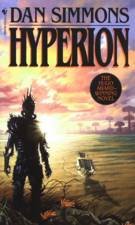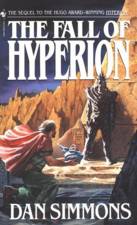

| Click on a book's image or title to order from Amazon.com |

Hyperion
Science Fiction Book Club, © 1989, 414 pp, ISBN #0-553-28368-5Reviewed January 2003
Hyperion is surely in many respects among the most impressive SF novels ever published, despite being only half a story (the conclusion is in the follow-up The Fall of Hyperion). Moreover, Hyperion is really a set of six linked novellas with a framing sequence.
The framing sequence follows the progress of seven pilgrims to the planet Hyperion on the eve of interstellar war, nine hundred years in the future. They make their way across the planet to the Valley of the Time Tombs, mysterious artifacts from the future which have been travelling back along with the enigmatic and murderous creature known as The Shrike. Legend has it that the Shrike might grant boons of pilgrims, though none have ever returned from a pilgrimage. On the journey, six of the seven pilgrims tell their stories, which include:
- A Jesuit priest, Lenar Hoyt, following in the footsteps of a previous priest, whose discovery of a lost human tribe on Hyperion led to some surprising and ultimately horrifying revelations about the world.
- A famous military commander, Fedmahn Kassad, seeking his true love, whom he met on Hyperion in the wake of an earlier war, and who seems tied to the Shrike somehow.
- An aging poet, Martin Silenus, who was part of an early wave of colonization of Hyperion. He was witness to the reign of Hyperion's vanished Sad King Billy, and who considers the Shrike to be his muse. He's returning to finish his epic Cantos.
- An elderly Jewish scholar, Sol Weintraub, whose daughter visited Hyperion 25 years earlier and who was struck at that time by a peculiar condition. Weintraub hopes to ask the Shrike to spare her life, having run out of options.
- A private detective from a high-gravity world, Brawne Lamia, whose last client was a "cybrid" - a human body with a mind in the computer Core on the net - who asked her to discover who killed him, and who is travelling to Hyperion at her former client's request.
- A Consul of the human Hegemony, whose story tells of a young man of decades past who fell in love with a woman and a world during the construction of the farcaster portal to the planet, and his sense of loss as he saw his love age and the world change as it moved toward integration with the Hegemony.
And there is a coherent story here, as the mysteries of Hyperion are gradually described and probed, as well as the larger story of the war and the Core, and the nature of the Hegemony, which is held together with its instantaneous farcaster Web. While the Shrike seems to be gathering some pieces in its fold, the Hegemony is staging a battle against hostile Ouster forces in Hyperion space. The Ousters are humans who fled planetary life centuries ago and live between the stars and separate from the Hegemony, but both sides see Hyperion as somehow crucial to humanity's future. And the cybernetic Core seems to be playing yet another game in the midst of this. Hyperion lays down the pieces of this larger story.
And yet the short tales which make up most of the book are satisfying in themselves, to varying degrees. The priest's tale is sharply chilling, and the Consul's tale mournfully touching. But the centerpiece of the novel is Sol Weintraub's story about his daughter Rachel's condition, which forces himself and his wife into the role of elderly caretakers while they search for a cure. Sol has strange dreams that he must offer his daughter to a mysterious presence on Hyperion, and he carries an internal dialogue with God about the choice of Abraham, who offered up his child to God in the Bible as a test of his obedience. Morally compelling, emotionally wrenching, it's one of the best science fiction stories published. (And I'm not going to ruin the impact by revealing the nature of Rachel's condition; read it for yourself!)
The book isn't a full success; there's an ongoing theme rooted in the poetry of John Keats which I found largely superfluous (probably due to my personal indifference towards poetry). The detective's tale is the most revealing of the larger machinations of the story, but it's the least interesting on its own, being a fairly straightforward plot-based adventure. And, of course, the books ends on a sudden cliffhanger.
But all-in-all Hyperion is a rousing success. If you read it, be sure to have the sequel on hand so you can launch into it at once. It's worth it.

The Fall of Hyperion
Science Fiction Book Club, © 1990, 511 pp, ISBN #0-553-28820-2Reviewed January 2003
This is the concluding half of the story begun in Hyperion. Whereas its predecessor is a set of six linked stories, The Fall of Hyperion is a traditionally-structured narrative with a large number of points of view, including the six pilgrims whose stories are told in the first book, Meina Gladstone, the CEO of the Hegemony, and Joseph Severn, a cybrid reconstruction of the deceased 19th-century poet John Keats.
The Time Tombs on Hyperion are opening, even as the pilgrims reach their Valley, and Hegemony and Ouster ships clash in the skies above. The Hegemony finds itself sorely beset by the Ousters, whose attack on humanspace seems planned over a span of decades.
Severn has a view of the Hegemony's leadership as Gladstone brings him in to witness the proceedings, and occasionally sends him out to see the reaction elsewhere in the Hegemony to the war. It's through Severn's eyes that we see how the Hegemony works: The instant connection through farcaster portals, the interaction with the cybernetic Core, the settling and integration of new worlds, the decadence of a culture with - until now - no serious adversaries.
Severn also dreams of the pilgrims and their experiences on Hyperion. Slowly, the mysteries behind their journeys are suggested and eventually revealed: What the crucifix that Lenar Hoyt wears is intended for. Who Kassad's beloved Moneta is and why she travels with the Shrike. What the Shrike's Tree of Pain is and does. Why Sol Weintraub's daughter has been afflicted as she has. And what the cybernetic Core is up to, how Brawne Lamia's cybrid client is involved, and how it connects to Hyperion.
And, of course, what the Shrike is.
It's a tremendous task, and one mustn't chastise Simmons for aiming so high. However, he doesn't quite hit his mark. Too many tasty points are finessed; the Time Tombs and the Shrike seem too much like magic at times, presented for effect rather than reason. It makes the book feel a little empty from time to time. And in particular I felt somewhat disappointed that Rachel Weintraub's fate was tied up in quite the manner it was; it felt not quite worthy of the terrific build-up it was presented in the first book.
Thematically, the book provides plenty to chew on: The nature of God, his (or her or its) relationship to man, and who creates whom; the relationship between different arms of humanity, and our cybernetic creations; and, of course, what prizes are worth the very highest prices, and when a man - or a society - is pushed to the point that they're willing to pay them. Almost everything here is played for very high stakes, and many of the key figures show the strength of their character through their actions under pressure. Occasionally a character seems perhaps more heroic than he really deserves to, but again, in such an ambitious undertaking the occasional rough edge can be forgiven.
It's clear that Simmons had the overall arc in mind when he assembled the seed stories in the first volume, and that's very satisfying, but Fall doesn't quite live up to the promise of the set-up in Hyperion. It's still a very good book, a real page-turner, but I wished that some of it had turned out differently.
hits since 20 January 2003.